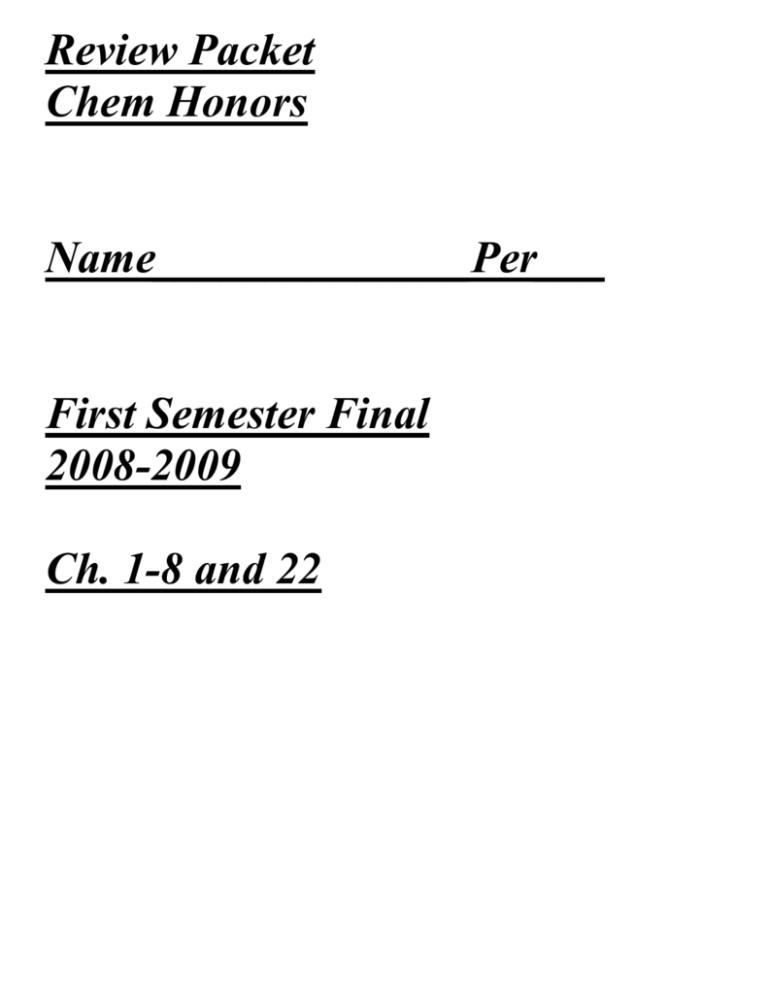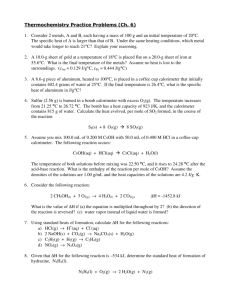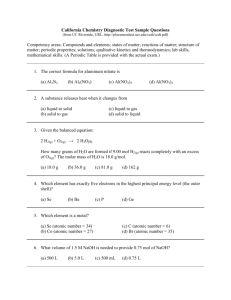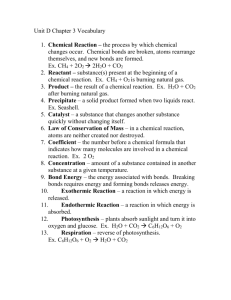Review Packet - mvhs
advertisement

Review Packet Chem Honors Name______________Per___ First Semester Final 2008-2009 Ch. 1-8 and 22 Review: 1 Questions you should be able to answer: (Ch. 1-5) 1. Distinguish between the following giving examples Atoms, Elements, and Compounds Extensive and Intensive Properties Physical and Chemical changes Mixtures and Pure substances Groups and Periods Metals, Non-metals, and metalloids Observation and Interpretation Accuracy and Precision Direct and Indirect Proportions (Mathematical expressions too) 2. What are the different stages in the “scientific method”? 3. How many significant figures are in the following measurements? a. 0.0005 g b. 110.0 ml c. 6.022 X 1023 d. 101 e. 10000 4. Compute the following to the correct number of significant digits a. 10.007 + 8.1 + 4.56 = b. 100.82/24 c. 2/89.4 5. Briefly describe Rutherford’s experiment and the conclusions that can be drawn from them. 6. What are “isotopes”? Taking chlorine as an example, how many isotopes does chlorine possess and how can you distinguish between them? 7. What is electromagnetic radiation? What are the properties of electromagnetic radiation? How are wavelength and frequency related? How are energy and frequency related? 8. Describe the Bohr model of the hydrogen atom with its two major shortcomings 9. Define the following Principle Quantum number Angular Momentum number Magnetic Quantum number Spin Quantum number Pauli’s exclusion principle Aufbau principle Hund’s Rule 10. Explain the trends seen in the variation of periodic properties (atomic radius, ionic radius, electron affinity, and electronegativity) across a period and down a group. 11. Write the electron configuratin of a. Al b. Cr2+ c. Ne d. Cu e. Br Review: 2 Chapter 6: Chemical Bonding Important Terminology and Concepts 1. Why do atoms form chemical bonds with other atoms? 2. What are the differences between ionic and covalent bonding and how can you predict the type of bonding that would result between two atoms? 3. Define some features of covalent bonds like bond length and bond energy etc. 4. State the octet rule and list two compounds that are exceptions to the rule. 5. List the various steps involved in drawing a Lewis electron dot structure, what are lone pairs and bonded pairs of electrons? 6. Draw Lewis Dot structures for the following molecules 1) ClO32) IF5 3)CO324)SiCl4 5)SO42For the molecules above, draw resonance structures if possible. What is resonance? What is ionic and metallic bonding? Give examples for each. VSEPR theory: What is the basis for this theory and how does this theory help to explain the molecular geometries of complicated molecules? Using VSEPR theory, predict the molecular geometries and molecular shapes for the following molecules: 1)IF5 2)ClF3 3)BF3 4)H2O 5)NH3 What is the hybridization of the central atom in the molecules above? Review: 3 Topics covered: Write and name ionic compounds, balance chemical equations and reaction stoichiometry. 1. Practice writing formulas Calcium sulfate Copper(II) chloride Iron(III) sulfide Potassium dichromate 2. Balance the following chemical equations a. Al4C3 + H2O CH4 + Al(OH)3 b. Al2(SO4)3 + Ca(OH)2 Al(OH)3 + CaSO4 c. Fe2O3(s) + CO(g) Fe(s) + CO2(g) d. H2SO4(aq) + NaOH(aq) Na2SO4(aq) + H2O e. C6H14(g) + O2 CO2(g) + H2O(g) 3. Stoichiometry problems ( DO NOT DO) a. CO2 + H2O C6H12O6 + H2O + O2 What mass of CO2 in grams is needed to react with 3.00 mol of H2O in the reaction above? Ans: 132 g CO2 b. N2H4 + H2O2 N2 + H2O 1) Which is the limiting reactant when 0.750 mol of N2H4 is mixed with 0.500 mol of H2O2? Ans: H2O2 2)How much of the excess reactant in moles remained unreacted? Ans:0.500 N2H4 3)How much of each product in moles is formed? Ans: 0.250 mol N2, 1.00 mol H2O c. When zinc and sulfur are heated together, they react to form Zinc sulfide according to the equation Zn(s) + S(s) ZnS(s) Suppose 12.00 g of Zinc is reacted with 7.50 g of sulfur 1) Which is the limiting reactant? 2) How much ZnS is formed? 3) How much of one of the reactants remained unreacted? Ans: 1) Zn is the limiting reactant 2) 17.9 g ZnS 3) 1.60 g excess S Review: 4 Topics covered: Stoichiometry Percent Yield Empirical Formula Chemical Equations Significant Figures Density Scientific Notation Chemical and Physical changes 1. Does each of the following describe a physical change or a chemical change? (a) the helium gas inside a balloon tends to leak out after a few hours. (b) A flashlight beam slowly gets dimmer and finally goes out. (c) Frozen orange juice is reconstituted by adding water to it. 2. How many significant figures are there in each of the following (a) 0.006 L, (b) 0.0605 dm (c) 60.5 mg 3. Express the answers to the following calculations in scientific notation: a. 0.0095 + (8.5 X 10-3) b. 653 / (5.75 X 10-8) c.850,000 – (9.0 X 105) d.(3.6 X 10-4) X (3.6 X 106) 4. Classify each of the following as an element, a compound, a homogeneous mixture, or a heterogeneous mixture: (a) seawater (b) helium gas (c) sodium chloride (table salt) (d) a bottle of soft drink (e) a milkshake (f) air (g) concrete. 5. In determining the density of a rectangular metal bar, a student made the following measurements: length: 3.53 cm, width: 2.4 cm, height: 1.0 cm, mass: 52.7064 g. Calculate the density of the metal to the correct number of significant figures. 6. Phoshporic acid (H3PO4) is a colorless, syrupy liquid used in detergents, fertilizers, and toothpastes, and in carbonated beverages for a “tangy” flavor. Calculate the percent composition by mass of H, P, and O in this compound. 7. A sample of compound of nitrogen (N) and Oxygen (O) contains 1.52 g of N and 3.47 g of O. The molar mass of this compound is known to be between 90 and 95g. Determine the molecular formula and molar mass of the compound. (DO NOT DO) 8. Ascorbic acid (vitamin C) cures scurvy and may help prevent the common cold. It is composed of 40.92 percent carbon (C), 4.58 percent hydrogen (H), and 54.50 percent oxygen (O) by mass. Determine its empirical formula. (DO NOT DO) 9. When aluminum metal is exposed to air, a protective layer of aluminum oxide (Al2O3) forms on its surface. This layer prevents further reaction between aluminum and oxygen, and is the reason why aluminum beverages cans don’t corrode. (In the case of iron, the rust, or iron (III) oxide, that forms is too porous to protect the iron metal underneath, so rusting continues). Write a balanced equation for the formation of Al2O3 10. The food we eat is degraded, or broken down, in our bodies to provide energy for growth and function. A general overall equation for this complex process represents the degradation of glucose (C6H12O6) to carbon dioxide (CO2) and water (H2O) C6H12O6 + 6O2 6CO2 + 6H2O If 856 g of C6H12O6 is consumed by a person over a certain period, what is the mass of CO2 produced? (DO NOT DO) Review: 5 Topics covered: Nuclear chemistry Chemical bonding Hybridization VSEPR Electron Configuration 1. How are scientists able to tell the age of a fossil? 2. Explain the effect of alpha particle emission, beta particle emission, gamma radiation, electron capture and positron emission on atomic number and mass number of the element. 3. Half life of Carbon-14 is 5770 years. What percent of the original radioactivity would be present after 28850 years (3.12%) 4. Does the molecules OCS have a higher or a lower dipole moment that CS2? 5. Describe the hybridization state of phosphorus in phosphorus pentabromide (PBr5) 6. Write a Lewis structure for SbCl5. Does this molecule obey the octet rule? 7. Draw three resonance structures for the CO32- ion. Show formal charges. 8. Arrange the following atoms in order of decreasing atomic radius: Na, Al, P, Cl, Mg 9. Which atom should have a smaller first ionization energy: oxygen or sulfur? 10. Shown below are portions of orbital diagrams representing the ground-state electron configurations of certain elements. Which of the them violates the Pauli exclusion principle? Which of them violates Hund’s rule? A b c 11. Which of the following species has the most unpaired electrons? S+, S, or S-? Explain how you arrive at your answer. 12. The ground-state electron configurations listed here are incorrect. Explain what mistakes have been made in each and write the correct electron configuration. Al: 1s22s22p43s23p3 B: 1s22s22p5 F: 1s22s22p6





